By Leen Randell
Updated: Jul 18, 2024
10 Best Herbal Creams For Cramps
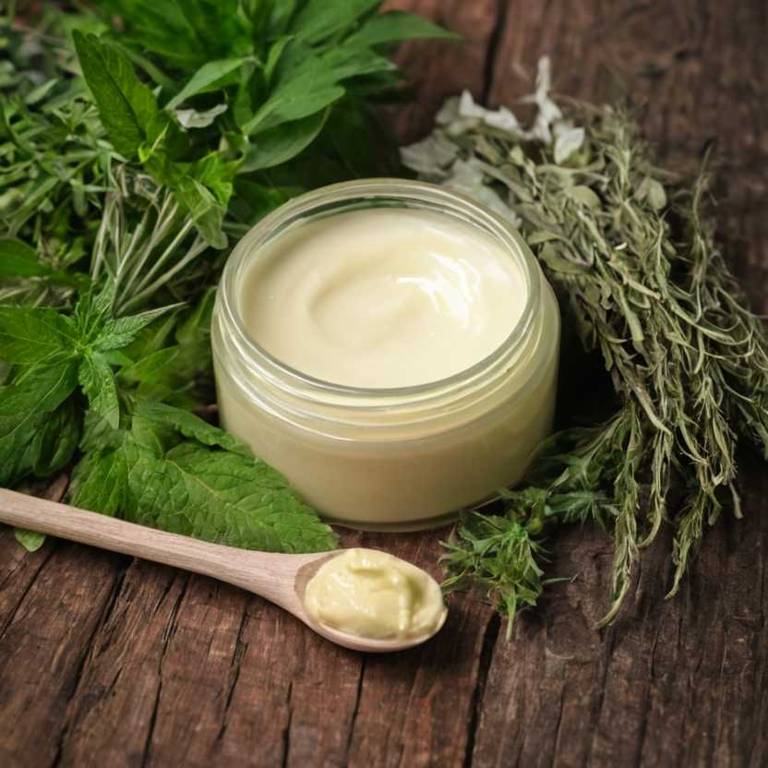
Herbal creams for cramps are topical products infused with natural herbs and essential oils that help alleviate menstrual cramps, pain, and discomfort.
These creams work by reducing inflammation and relaxing muscles, providing quick relief from cramps. Examples of herbal creams for cramps include clary sage, ginger, and peppermint creams.
By using these creams, women can experience reduced pain, improved mood, and increased productivity, allowing them to live their lives more comfortably and confidently.
The following article describes in detail the most important creams for cramps, including medicinal properties, parts of herbs to use, and recipes for preparations.
- 1. Viburnum opulus
- 2. Lavandula angustifolia
- 3. Salvia sclarea
- 4. Zingiber officinale
- 5. Curcuma longa
- 6. Angelica sinensis
- 7. Trifolium pratense
- 8. Leonurus cardiaca
- 9. Vitex agnus castus
- 10. Tanacetum parthenium
- What is the best combination of herbal creams to use for cramps?
- What ailments similar to cramps are treated with herbal creams?
1. Viburnum opulus
Viburnum opulus, also known as guelder rose, creams helps with cramps because of its rich content of salicin and other bioactive compounds.
These compounds work by relaxing the uterine muscles, reducing inflammation and alleviating spasms that cause menstrual cramps. Additionally, the creams' anti-oxidant and anti-inflammatory properties help to soothe and calm the body, providing quick relief from crampy discomfort.
As a result, Viburnum opulus creams have become a popular natural remedy for menstrual cramps and associated symptoms.
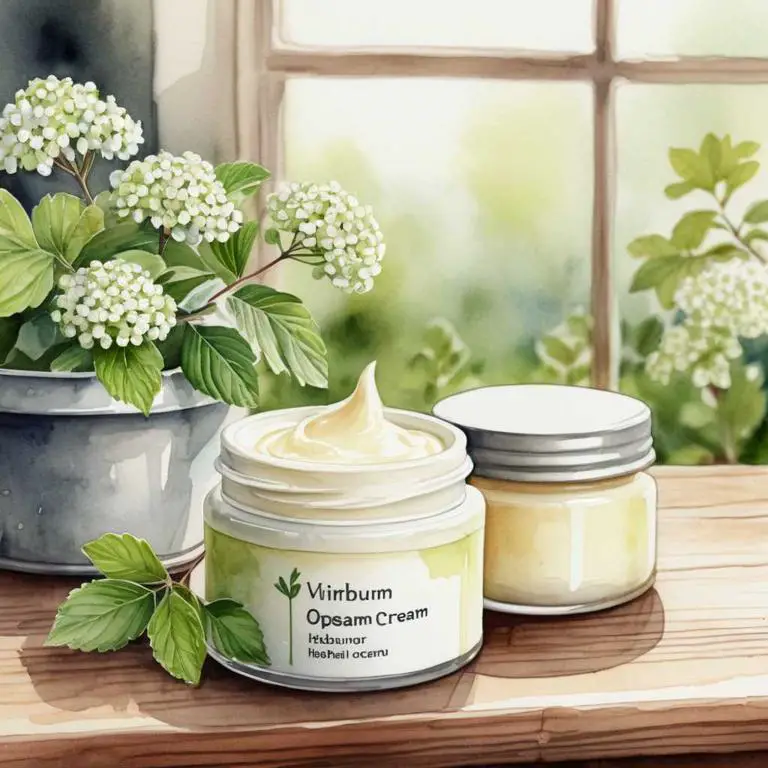
Medicinal Constituents
The list below shows the primary medicinal constituents in Viburnum opulus creams that help with cramps.
- Scopoletin: This coumarin derivative has a sedative effect, helping to relax muscles and reduce cramping by influencing the nervous system.
- Isoferulic acid: This phenolic compound has anti-inflammatory and antispasmodic properties, which help to reduce muscle spasms and alleviate cramping.
- Viburnin: This alkaloid has a sedative and antispasmodic effect, helping to calm muscle contractions and ease cramping.
Parts Used
The list below shows the primary parts of guelder rose used to make creams for cramps.
- Buds: They are used to make creams for cramps due to their analgesic and anti-inflammatory properties.
- Leaves: The leaves are used to create creams for cramps because they have a spasmolytic effect, helping to relieve muscle cramps.
- Fruits: The fruits of Viburnum opulus are used to make creams for cramps due to their anti-inflammatory and sedative properties.
Quick Recipe
The following recipe gives a procedure to make a basic guelder rose for cramps.
- Harvest the viburnum opulus leaves and flowers in late summer or early fall when they are fresh and full of fragrance.
- Dry the harvested viburnum opulus material in a warm dark place for 7 to 10 days to reduce moisture content.
- Combine 20 grams of dried viburnum opulus with 100 grams of carrier oil in a clean glass jar and steep for 2 weeks.
- Strain the mixture through a cheesecloth and discard the solids then add 10 grams of beeswax to the oil and heat until melted.
- Pour the melted mixture into small tin containers and allow to cool and solidify before use as a topical cream.
2. Lavandula angustifolia
Lavandula angustifolia, also known as English lavender, creams helps with cramps because of its natural anti-inflammatory and soothing properties.
The active compounds in lavender, such as linalool and linalyl acetate, have a calming effect on the body, reducing muscle tension and spasms that cause cramps.
Additionally, lavender's antispasmodic properties help to relax the uterine muscles, providing relief from menstrual cramps and promoting a restful night's sleep, making it a popular natural remedy for cramp relief.

Medicinal Constituents
The list below shows the primary medicinal constituents in Lavandula angustifolia creams that help with cramps.
- Linalool: This terpene has been shown to have a relaxing effect on the muscles, reducing muscle spasms and cramps by inhibiting the release of neurotransmitters that stimulate muscle contractions.
- Linalyl acetate: Similar to linalool, linalyl acetate is a terpene that has been found to have a calming effect on the nervous system, helping to reduce muscle tension and alleviate cramps.
- Rosmarinic acid: This phenolic compound has been shown to have a potent anti-inflammatory effect, which can help to reduce muscle inflammation and discomfort associated with cramps, while also having a relaxing effect on the muscles.
Parts Used
The list below shows the primary parts of english lavender used to make creams for cramps.
- Flowers: They are used due to their high concentration of linalool and linalyl acetate, which have analgesic and anti-inflammatory properties that help soothe cramps.
- Leaves: Leaves contain similar compounds to flowers and are used for their calming effects and ability to reduce pain and inflammation associated with cramps.
- Stems: Stems of Lavandula angustifolia contain a lesser amount of essential oils compared to flowers and leaves, but still contribute to the overall analgesic and anti-inflammatory properties of the creams.
Quick Recipe
The following recipe gives a procedure to make a basic english lavender for cramps.
- Harvest 1 cup of dried lavandula angustifolia flowers in early morning to preserve essential oils.
- Combine 1 cup of dried flowers with 2 cups of distilled water in a saucepan.
- Simmer the mixture at 100-110°f for 10-15 minutes to release plant compounds.
- Strain the mixture through a cheesecloth or fine-mesh sieve into a clean bowl.
- Mix 1/2 cup of beeswax and 1/4 cup of shea butter with 1/4 cup of the herbal infusion.
3. Salvia sclarea
Salvia sclarea, also known as sage, creams helps with cramps because of its natural anti-inflammatory and pain-relieving properties.
The essential oils present in sage, such as camphor and borneol, have a cooling effect on the skin, which can help to relax tense muscles. Additionally, sage has a sedative effect on the nervous system, reducing muscle spasms and cramping.
By applying a sage cream to the affected area, you can experience relief from menstrual cramps, muscle spasms, and other types of cramping.
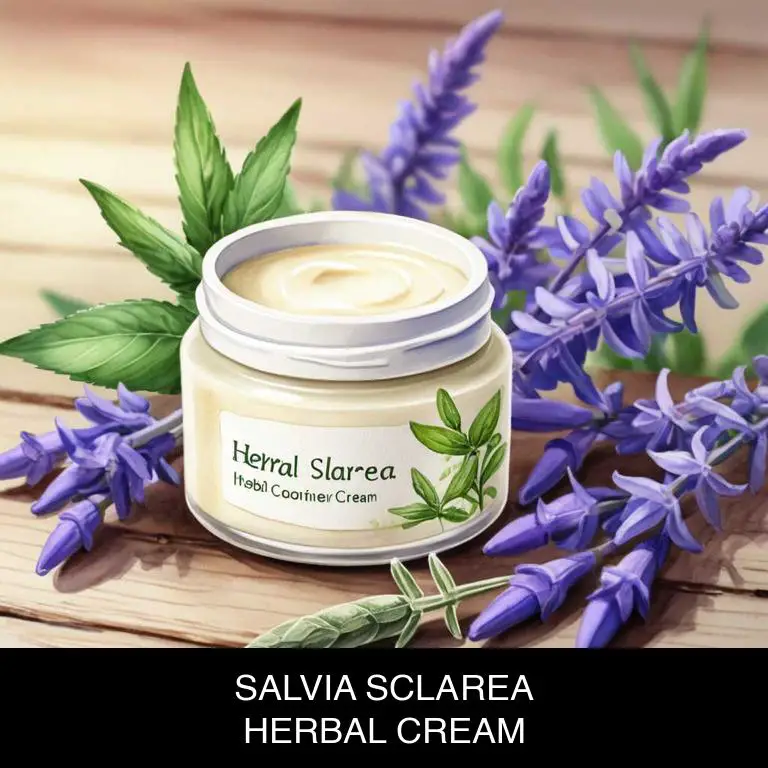
Medicinal Constituents
The list below shows the primary medicinal constituents in Salvia sclarea creams that help with cramps.
- Terpenes: Terpenes present in Salvia sclarea creams have anti-inflammatory and antispasmodic properties, which help relax muscles and reduce cramp severity.
- Rosmarinic acid: Rosmarinic acid in Salvia sclarea creams has potent anti-inflammatory and antioxidant effects, which help alleviate cramp pain and reduce muscle spasms.
- Camphor: Camphor in Salvia sclarea creams has a mild antispasmodic effect, helping to relax muscles and reduce cramp intensity by reducing nerve activity.
Parts Used
The list below shows the primary parts of sage used to make creams for cramps.
- Leaves: Leaves are used due to their high content of salvinorin, which is believed to help alleviate menstrual cramps and other pain-related issues.
- Flowers: Flowers are used due to their essential oil content, which includes sesquiterpenes that have analgesic and anti-inflammatory properties.
- Stems: Stems are used due to their ability to provide a concentrated source of essential oils, which are used in creams to help soothe and calm cramping muscles.
Quick Recipe
The following recipe gives a procedure to make a basic sage for cramps.
- Extract 10 grams of dried salvia sclarea flowers in a glass beaker using a solvent like glycerin or ethanol.
- Combine the extracted plant material with 50 grams of beeswax in a double boiler to melt the wax.
- Add 100 grams of coconut oil to the melted beeswax mixture and stir for 5 minutes to combine.
- Remove the double boiler from the heat and add 10 grams of vitamin e oil to the mixture.
- Pour the cooled mixture into a container and store it in a cool dark place for 2 weeks before use.
4. Zingiber officinale
Zingiber officinale, also known as ginger, creams helps with cramps because of its anti-inflammatory properties.
The active compounds in ginger, such as gingerol and shogaol, have been shown to reduce pain and relax muscles. When applied topically, these compounds can penetrate the skin and help alleviate cramp symptoms. Additionally, the warming sensation produced by ginger creams can help increase blood flow to the affected area, further reducing cramp severity and promoting relaxation.
This natural remedy offers a soothing and effective solution for menstrual cramps.
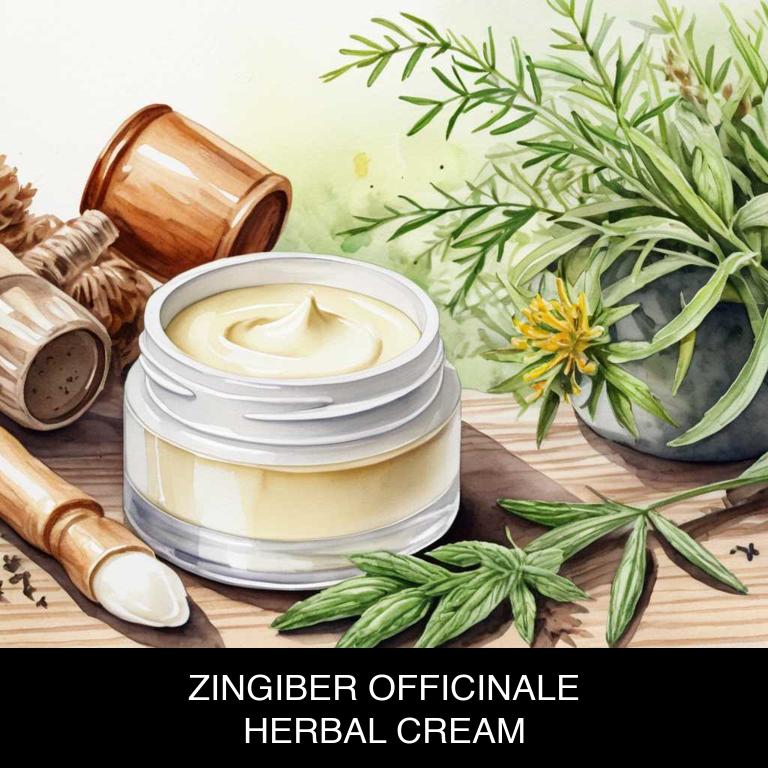
Medicinal Constituents
The list below shows the primary medicinal constituents in Zingiber officinale creams that help with cramps.
- Gingerols: These sesquiterpene compounds have analgesic and anti-inflammatory properties, helping to reduce pain and discomfort associated with menstrual cramps.
- Shogaols: Similar to gingerols, shogaols are also responsible for ginger's anti-inflammatory and analgesic effects, which can help alleviate cramping and spasms.
- 6-gingerol: As a potent analgesic and anti-inflammatory compound, 6-gingerol helps to relax smooth muscle tissue, reducing the severity and frequency of menstrual cramps.
Parts Used
The list below shows the primary parts of ginger used to make creams for cramps.
- Roots: Roots are used because they contain a high amount of gingerols, which help to relax muscles and reduce cramping.
- Buds: Buds are used for their high content of gingerols and other bioactive compounds that have a calming effect on the body and help to alleviate cramping.
Quick Recipe
The following recipe gives a procedure to make a basic ginger for cramps.
- Harvest 10 grams of fresh zingiber officinale roots in late spring or early summer when the plants are mature.
- Dry the harvested roots in a single layer at 50°c for 24 hours to prevent moisture retention.
- Grind the dried zingiber officinale roots into a fine powder using a coffee grinder for 30 seconds.
- Mix 5 grams of the ground zingiber officinale powder with 50 grams of a neutral base cream in a double boiler.
- Allow the mixture to emulsify and cool to room temperature over 30 minutes before applying.
5. Curcuma longa
Curcuma longa, also known as turmeric, creams helps with cramps because it contains curcumin, a potent anti-inflammatory compound that reduces muscle spasms and relaxes the uterine muscles.
The bioavailability of curcumin in topical creams allows it to directly target the affected area, providing quick relief from cramps. Additionally, curcuma longa creams may also help regulate menstrual cycles and reduce oxidative stress, further alleviating cramp-related discomfort and promoting overall well-being.
This makes it a popular natural remedy for menstrual cramps.
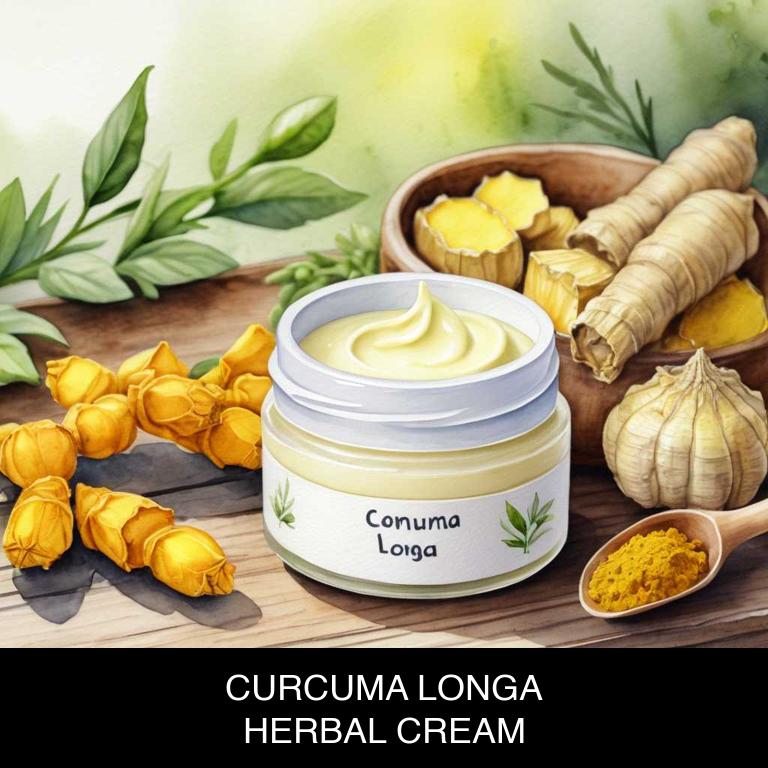
Medicinal Constituents
The list below shows the primary medicinal constituents in Curcuma longa creams that help with cramps.
- Curcumin: Curcumin is a phenolic compound that helps with cramps by inhibiting the production of prostaglandins, which are hormone-like substances that cause muscle contractions and pain.
- Turmerone: Turmerone is a terpene that helps with cramps by reducing inflammation and relaxing muscle spasms, providing relief from pain and discomfort.
- Demethoxycurcumin: Demethoxycurcumin is a curcuminoid that helps with cramps by inhibiting the activity of COX-2 enzymes, which are involved in the production of prostaglandins and other inflammatory mediators.
Parts Used
The list below shows the primary parts of turmeric used to make creams for cramps.
- Rhyzomes: Used due to their high turmeric content, which has anti-inflammatory and antispasmodic properties that help alleviate cramp symptoms.
- Roots: Utilized for their rich content of curcuminoids, which have potent analgesic and anti-inflammatory effects that provide relief from cramps.
- Leaves: Employed for their essential oils, which have antispasmodic and anti-inflammatory properties that help ease cramp pain and discomfort.
Quick Recipe
The following recipe gives a procedure to make a basic turmeric for cramps.
- Weigh 2 tablespoons of curcuma longa powder and 2 tablespoons of beeswax.
- Melt 2 tablespoons of coconut oil and 2 tablespoons of shea butter in a double boiler.
- Add 2 tablespoons of honey and 2 tablespoons of distilled water to the melted mixture.
- Whip the mixture with an electric mixer for 5 minutes until it thickens.
- Pour the mixture into small jars and refrigerate for 30 minutes before use.
6. Angelica sinensis
Angelica sinensis, also known as dong quai, creams helps with cramps because of its natural anti-inflammatory properties and ability to relax muscles.
The herb contains compounds like ferulic acid and ligustilide, which help to reduce muscle spasms and ease cramp-related pain. Additionally, Angelica sinensis creams may help to regulate hormonal imbalances, which can contribute to menstrual cramps.
By applying these creams topically, individuals can experience relief from cramps and discomfort, making them a popular natural remedy for menstrual relief.
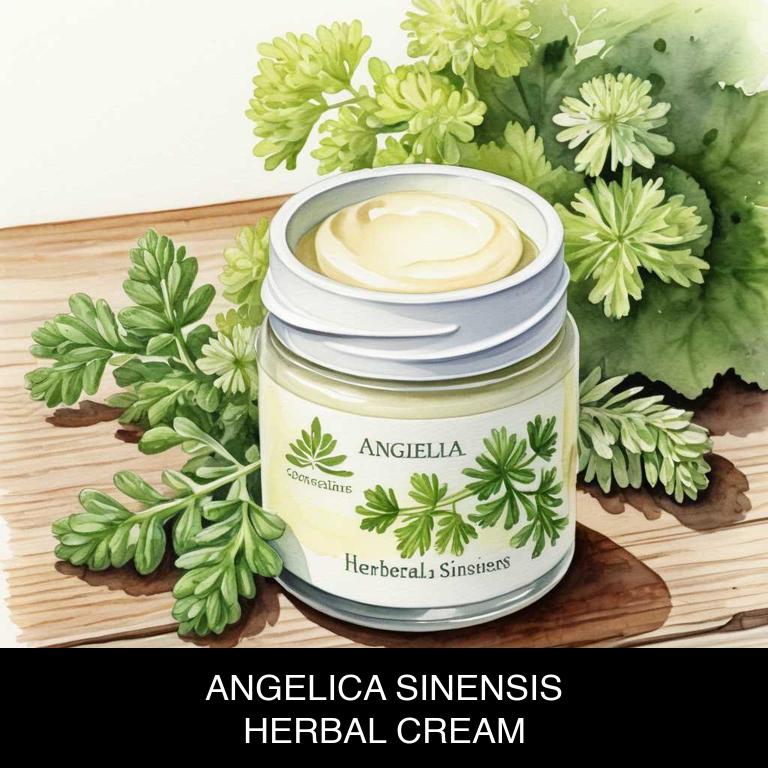
Medicinal Constituents
The list below shows the primary medicinal constituents in Angelica sinensis creams that help with cramps.
- Fern-8-gingerol: This sesquiterpene lactone has anti-inflammatory properties, which can help reduce muscle spasms and alleviate cramp symptoms.
- Ligustilide: A non-terpenoid compound with a sedative effect, ligustilide can help relax smooth muscle and reduce muscle cramps.
- Butylphthalide: A sesquiterpene lactone with analgesic and anti-inflammatory properties, butylphthalide can help relieve pain and reduce muscle spasms associated with cramps.
Parts Used
The list below shows the primary parts of dong quai used to make creams for cramps.
- Roots: Angelica sinensis roots are the most commonly used part for making creams to alleviate cramps due to their high content of ferulic acid and other bioactive compounds that help relax the uterus.
- Rhyzomes: Angelica sinensis rhyzomes are also widely used for their anti-inflammatory properties, which help reduce cramp pain and discomfort.
- Seeds: Angelica sinensis seeds are sometimes used in combination with other parts to enhance the effectiveness of the creams due to their reported uterine relaxing properties.
Quick Recipe
The following recipe gives a procedure to make a basic dong quai for cramps.
- Dry 500g of angelica sinensis roots in a low-temperature oven at 50c for 2 hours.
- Grind 200g of dried angelica sinensis roots into a fine powder using a mortar and pestle.
- Combine 200g of the ground angelica sinensis powder with 200g of beeswax and 200g of coconut oil in a double boiler.
- Heat the mixture in a double boiler at 60c for 30 minutes until the beeswax and coconut oil melt.
- Strain the hot mixture through a cheesecloth and bottle it for use as a herbal angelica sinensis cream.
7. Trifolium pratense
Trifolium pratense, also known as red clover, creams helps with cramps because of its high concentration of isoflavones, particularly formononetin and genistein.
These compounds mimic the body's natural estrogen, which can help to regulate menstrual cycles and reduce the severity of cramps. The anti-inflammatory properties of red clover also help to soothe the uterine lining, reducing spasms and discomfort associated with menstrual cramps.
As a result, red clover creams have become a popular natural remedy for alleviating menstrual cramp symptoms.
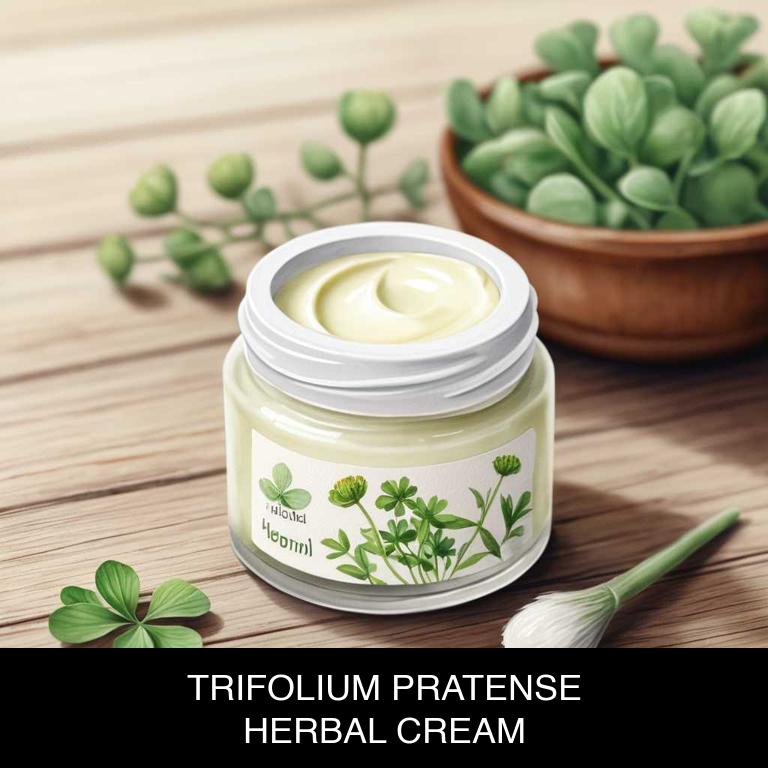
Medicinal Constituents
The list below shows the primary medicinal constituents in Trifolium pratense creams that help with cramps.
- Isoflavones: Isoflavones, particularly genistein and daidzein, help with cramps by reducing prostaglandin production, which contributes to muscle contraction and pain.
- Phenolic acids: Phenolic acids, such as ferulic acid and sinapic acid, may help alleviate cramps by reducing inflammation and oxidative stress, thereby relaxing muscle spasms.
- Coumarins: Coumarins, including coumarin and esculetin, may contribute to cramp relief by modulating the activity of ion channels and receptors involved in muscle contraction and relaxation.
Parts Used
The list below shows the primary parts of red clover used to make creams for cramps.
- Flowers: They contain isoflavones, which have estrogen-like properties that help to relax the uterine muscles and alleviate menstrual cramps.
- Roots: They are rich in coumarins, which have anti-inflammatory properties that help to reduce pain and discomfort associated with cramps.
- Leaves: They contain salicylic acid, a compound similar to aspirin, which helps to reduce inflammation and alleviate pain caused by cramps.
Quick Recipe
The following recipe gives a procedure to make a basic red clover for cramps.
- Harvest 1 cup of trifolium pratense flowers and leaves by cutting them at the base of the plant with scissors.
- Dry the trifolium pratense flowers and leaves in a warm place for 1-2 weeks or using a dehydrator for 6-8 hours.
- Steep 1/2 cup of dried trifolium pratense in 2 cups of carrier oil such as coconut or olive oil for 2-4 weeks.
- Strain the infused oil through a cheesecloth or a coffee filter into a clean container and discard the solids.
- Mix the infused oil with a preservative such as vitamin e oil and beeswax to create a stable and moisturizing cream.
8. Leonurus cardiaca
Leonurus cardiaca, also known as motherwort, creams helps with cramps because of its natural ability to relax uterine muscles and regulate menstrual cycles.
The herb contains compounds such as iridoid glycosides and flavonoids, which have a calming effect on the body. By reducing spasms and inflammation, Leonurus cardiaca creams can provide relief from menstrual cramps and associated discomfort.
This natural remedy has been used for centuries to soothe and calm the body, promoting a sense of well-being and comfort during times of cramping.
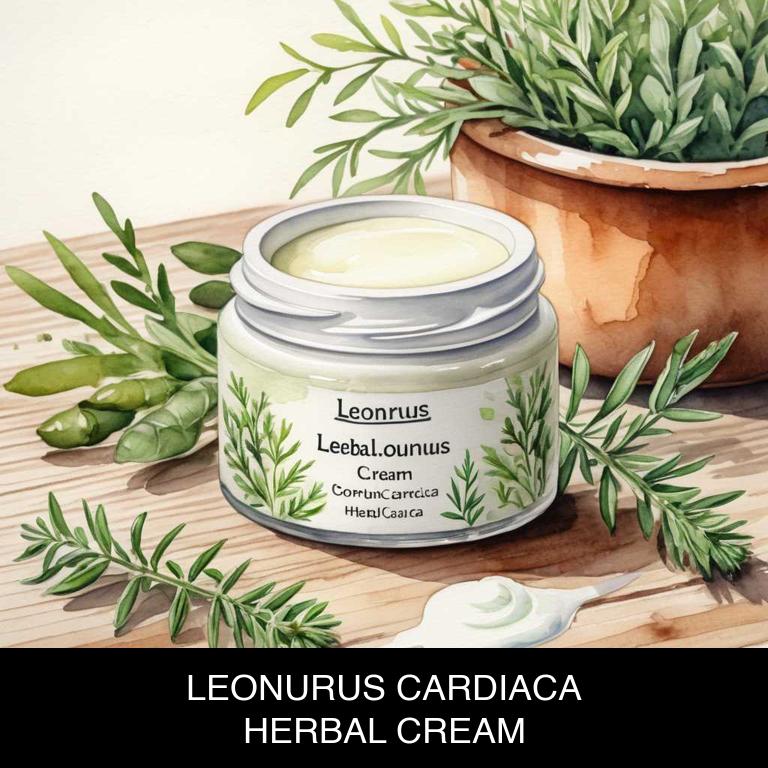
Medicinal Constituents
The list below shows the primary medicinal constituents in Leonurus cardiaca creams that help with cramps.
- Levonurine: A phenolic compound that acts as a muscle relaxant and helps to reduce cramp symptoms by soothing muscle spasms and promoting relaxation.
- Rosmarinic acid: A phenolic diterpene that exhibits anti-inflammatory and antispasmodic properties, helping to reduce muscle cramps by inhibiting muscle contractions and alleviating pain.
- Levostilbene: A phenolic compound with vasodilatory and anti-inflammatory properties, which can help to relieve cramp symptoms by improving blood flow, reducing inflammation, and relaxing muscles.
Parts Used
The list below shows the primary parts of motherwort used to make creams for cramps.
- Leaves: The leaves contain essential oils and flavonoids that have anti-inflammatory and spasmolytic properties, helping to relieve cramps.
- Roots: The roots of Leonurus cardiaca are rich in iridoids, which have been shown to have a sedative effect on the uterus and help alleviate menstrual cramps.
- Flowers: The flowers of Leonurus cardiaca contain flavonoids and essential oils that can help to relax the uterine muscles and reduce spasms associated with menstrual cramps.
Quick Recipe
The following recipe gives a procedure to make a basic motherwort for cramps.
- Harvest 25g of dried leonurus cardiaca flowers and leaves by cutting them above the node using clean scissors.
- Combine the dried plant material with 500ml of carrier oil such as coconut oil in a clean glass jar.
- Steep the mixture for 2 weeks in a cool dark place by shaking the jar daily.
- Strain the mixture through a cheesecloth into a clean glass container and discard the solids after 2 hours.
- Mix 10g of beeswax and 10g of shea butter into 50ml of the infused oil and heat the mixture gently until smooth.
9. Vitex agnus castus
Vitex agnus castus, also known as chaste tree, creams helps with cramps because they contain the active compound aucubin, which has anti-inflammatory properties.
This helps to relax the uterine muscles, reducing the severity of menstrual cramps. Additionally, the cream's hormonal balancing effects can help regulate the menstrual cycle, leading to fewer and less severe cramps.
The cream may also have a sedative effect, promoting relaxation and reducing overall discomfort associated with menstrual cramps.
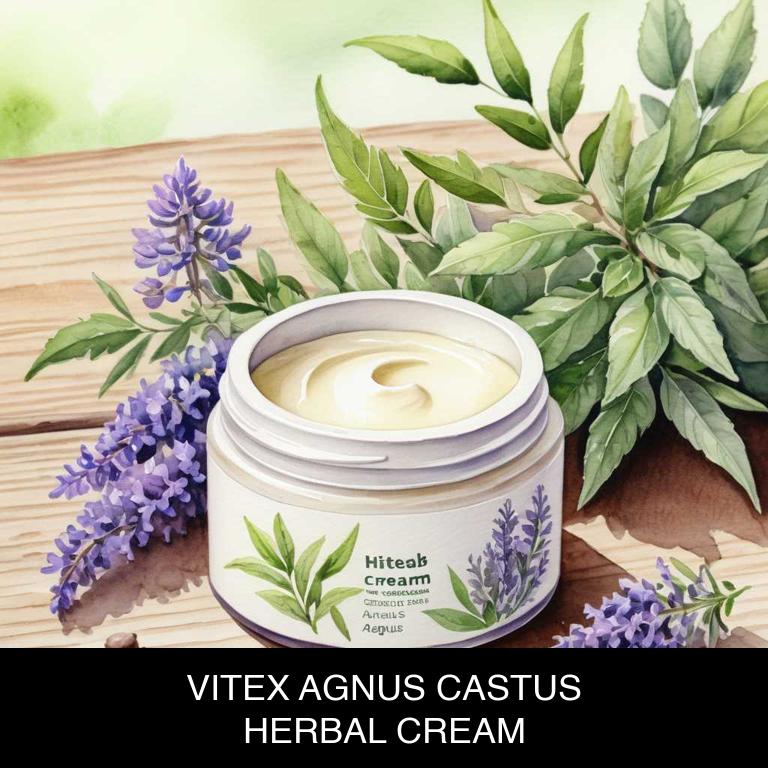
Medicinal Constituents
The list below shows the primary medicinal constituents in Vitex agnus castus creams that help with cramps.
- Agnuside: This alkaloid helps alleviate cramps by exerting a relaxing effect on smooth muscle tissues, reducing spasms and pain associated with menstrual cramps.
- Iridoid glycosides: These compounds have anti-inflammatory and spasmolytic properties, which help reduce inflammation and relax smooth muscle tissues, providing relief from cramps.
- Rosmarinic acid: This phenolic compound helps combat oxidative stress, inflammation, and pain associated with menstrual cramps, promoting a relaxing effect on the uterus and reducing discomfort.
Parts Used
The list below shows the primary parts of chaste tree used to make creams for cramps.
- Flowers: They are used due to their high content of flavonoids, which are believed to have a relaxing effect on the uterine muscles, thereby reducing menstrual cramps.
- Leaves: They are used as they contain iridoid glycosides, which are thought to have a spasmolytic effect, helping to ease menstrual cramp pain.
- Seeds: They are used due to their high content of ursolic acid, a compound with anti-inflammatory and antispasmodic properties, which can help alleviate menstrual cramps.
Quick Recipe
The following recipe gives a procedure to make a basic chaste tree for cramps.
- Harvest dried vitex agnus castus flowers and leaves at the end of the growing season for maximum potency.
- Combine 2 ounces of dried vitex agnus castus with 2 ounces of jojoba oil in a clean glass jar.
- Steep the mixture in a double boiler for 2 hours at 160°f to 180°f to infuse oils.
- Strain the mixture through a cheesecloth and discard the solids after 30 minutes of steeping time.
- Blend the infused oil with 1 ounce of beeswax and 1 tablespoon of vitamin e oil to thicken the cream.
10. Tanacetum parthenium
Tanacetum parthenium, also known as feverfew, creams helps with cramps because of its unique ability to reduce prostaglandins, hormone-like substances that stimulate uterine contractions.
By inhibiting the production of these prostaglandins, the creams can help alleviate menstrual cramps, also known as dysmenorrhea. Additionally, feverfew contains anti-inflammatory compounds that may help to relax the uterine muscles, further reducing cramp severity.
This natural remedy has been used for centuries to provide relief from menstrual cramps, making it a popular choice for those seeking a more holistic approach to pain management.
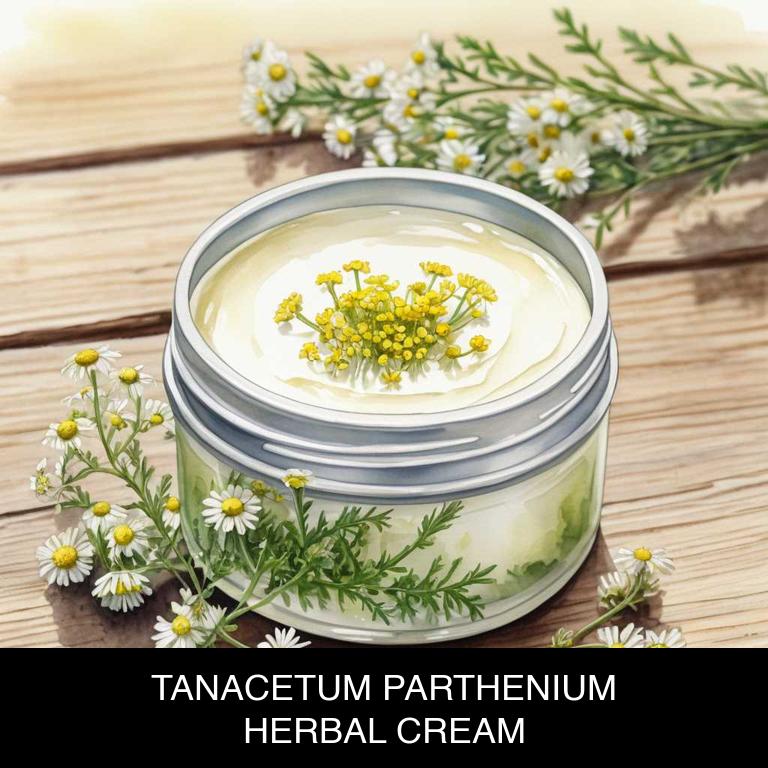
Medicinal Constituents
The list below shows the primary medicinal constituents in Tanacetum parthenium creams that help with cramps.
- Parthenolide: This sesquiterpene lactone has analgesic and anti-inflammatory properties, which can help to reduce muscle spasms and alleviate cramp pain.
- Tannins: These polyphenolic compounds have astringent and antispasmodic effects, which can help to relax muscles and reduce cramping.
- Flavonoids: These plant metabolites have anti-inflammatory and antispasmodic properties, which can help to reduce muscle spasms and alleviate cramp pain.
Parts Used
The list below shows the primary parts of feverfew used to make creams for cramps.
- Leaves: The leaves are used due to their high concentration of salvene, a compound that has analgesic and anti-inflammatory properties.
- Flowers: The flowers are used because they contain tannins and other compounds that can help relax muscles and reduce pain associated with cramps.
- Roots: The roots are used for their ability to ease cramps and spasms due to their content of sesquiterpene lactones, which have anti-inflammatory properties.
Quick Recipe
The following recipe gives a procedure to make a basic feverfew for cramps.
- Harvest fresh tanacetum parthenium flowers and leaves in the early morning to ensure optimal potency and aroma.
- Dry the tanacetum parthenium flowers and leaves in a warm area for 2-3 weeks to remove excess moisture.
- Infuse 200g of dried tanacetum parthenium flowers and leaves in 1 liter of carrier oil such as sweet almond oil for 2-3 weeks.
- Strain the infused oil through a cheesecloth or coffee filter to remove the plant material and obtain the herbal oil.
- Mix 100g of the herbal oil with 100g of beeswax and 50g of cocoa butter to create a smooth and stable cream base.
What is the best combination of herbal creams to use for cramps?
The best combination of herbal creams that help with cramps is often a blend of peppermint, ginger, and clary sage.
Peppermint oil has natural anti-inflammatory properties that help relax the muscles, while ginger cream provides a soothing warmth to ease cramp discomfort. Clary sage, with its calming effects, helps to reduce stress and promote relaxation, further alleviating cramp symptoms. Applying these herbal creams in moderation can provide relief from menstrual cramps and promote overall well-being.
This combination is a popular and effective remedy for cramp relief.
What ailments similar to cramps are treated with herbal creams?
Ailments similar to cramps/creams.html">cramps/creams.html">cramps that are treated with herbal creams are fibromyalgia, arthritis, and muscle strain.
Herbal creams containing ingredients like arnica, capsaicin, and menthol help alleviate pain and inflammation by reducing swelling and promoting blood flow.
These natural remedies also soothe stiff joints and muscles, providing relief from discomfort and stiffness associated with these conditions.